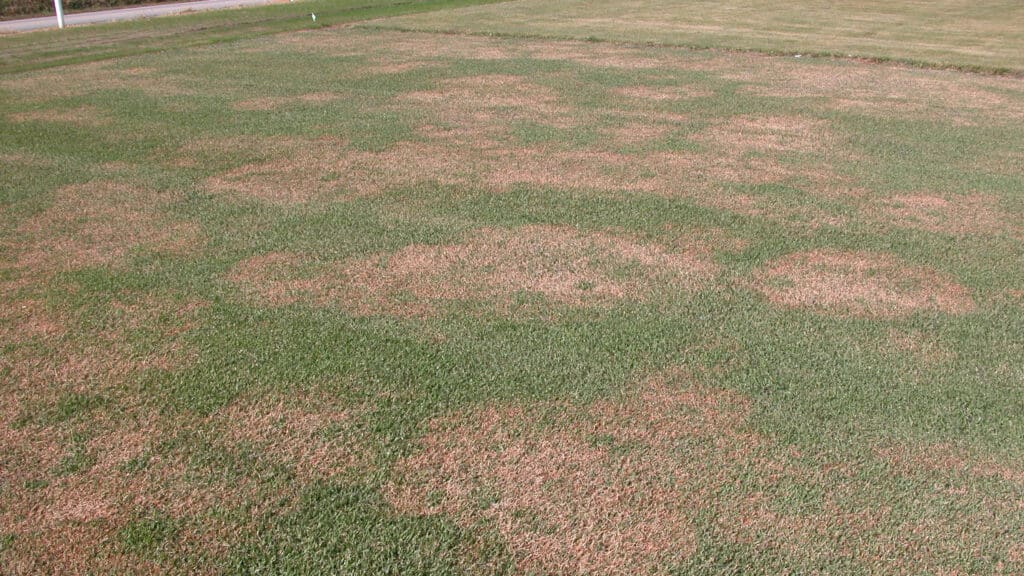If you live in Georgia or another southern state, you can count on the appearance of fire ant mounds in the year's late spring. To be such tiny little pests, ants can cause a lot of turmoil in home lawns, hayfields, and pastures. They are one of the most detested insects. Many people are stung […]

Pride In Turf is a local lawn fertilizer service in Atlanta. We come across fungus disease daily in our work. Zoysia patch fungus, often referred to as large patch, is probably the most common and severe disease of warm season grasses across Georgia, especially lawns with zoysia and St. Augustine grass.
Circular patches of turf affected with zoysia (large) patch fungus are most apparent in the spring and fall when warm season turfgrasses are either entering or exiting their winter dormancy period.
Cause of Zoysia Patch
This fungal disease is caused by the fungus Rhizoctonia solani. Zoysia patch fungus, or large patch, can appear in home lawns, landscapes, sports fields, golf courses, or sod farms. It occurs in spring and fall when turfgrasses are breaking dormancy and the environmental conditions are wet and mild.
Symptoms and Signs
Circular patches of affected areas can easily be observed in the lawn, as the diameter of the patches can range from 3 to 26 feet. Leaves of recently infected areas of zoysia patch fungus, located at the periphery of the patch may appear bright yellow or orange in color.
Sometimes, the disease may be perennial and recur in the same location year after year. When this occurs the diameter of the patches expands.
Water-soaked, reddish-brown or black lesions are observed when the R. solanni infection occurs on the grass leaves. Due to leaf sheath infections, dieback spreads from the leaf tip toward the base.
These diseased areas show symptoms of thin and sunken areas which develop in the patches and may be invaded by weeds. As the disease becomes more extensive, turf quality is reduced, disturbing the aesthetic value of the lawn.
Conditions favorable for Disease Development
Grasses are very susceptible to attack by pathogens in weather conditions where the temperatures of the thatch layer is between 50 and 70 degrees F and there is continuous moisture for 48 hours or more. Warm soil temperatures of over 80 degrees during the day and night temperatures of over 55 degrees are favorable conditions for disease.
Zoysia grass and warm-weather lawn grasses are not growing vigorously during early spring and fall. This can also occur during periods of cool weather in the summer, especially in shaded and/or wet areas
Excessive moisture levels in the soil, thatch, and lower turf canopy encourage the development of zoysia patch in lawns. Also, conditions such as poor drainage, restricted air movement, or excessive irrigation can increase the severity of this fungus in the lawn. This is true especially when these conditions occur for extended periods.
Brown Patch vs. Large Patch
The primary difference between these two fungal diseases is the grass they affect. While brown patch generally affects cool season grass (tall fescue, bluegrass), large patch only affects warm season grass such as zoysia and St. Augustine.
Brown patch disease in your lawn is easy to identify due to the large areas of dead grass the disease creates. It generally creates thin, circular patches of brown grass in lawns. Brown patch can be confused with large patch. The primary difference is the type of grass brown patch affects.
Control Zoysia Patch Fungus
Due to the damage to your lawn with zoysia patch or large patch fungus, it is best to use a multi-pronged approach to management. There should be a combination of genetic control, cultural control, and chemical control.
Genetic Control
It is best to establish a turfgrass species best adapted to your geographical area, location, situation, and landscape. All warm season grasses are susceptible to this fungal disease. In the Piedmont region of Georgia, zoysiagrass and centipedegrass usually show more dramatic symptoms.
Bermudagrass may also develop large patch at similar levels; however, this type of grass may recover more quickly.
Contact Pride in Turf to determine the best type of grass for your area and your lawn.
Cultural Controls
The following are some of the factors to consider:
**Make sure all areas drain well in your lawn, as moisture levels in the thatch and soil are an essential aspect of management. Poor soil drainage should be taken care of to prevent lawn diseases.
**Prevent and/or alleviate soil compaction and excessive thatch.
**Implement a sound program of fertilization according to recommended guidelines for your particular lawn. It's a good idea to get an updated soil test. Slow release nitrogen fertilizers only should be used.
Fertilize to maintain adequate but not lush growth during the growing season. Properly fertilized turf will recover quicker from disease injury than will under-fertilized turf.
**Cut grass at the proper mowing height for that type of grass. Generally, symptoms are more severe at low mowing heights.
Chemical Control
There are few fungicides available for the general public to use to manage zoysia patch control. You should contact a professional in order have this taken care of appropriately.
Contact Pride in Turf
Contact Pride in Turf to provide fungicide applications and provide professional services for any grass types you have in your lawn.
Pride in Turf can obtain and use the appropriate fungicide to treat any lawn diseases needed - ones that you do not have access to. Pride in Turf has professionals who will determine the best fungicide to treat your lawn.
Pride in Turf wants your lawn to be the envy of the neighborhood.
